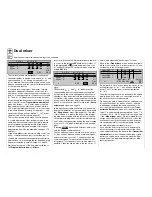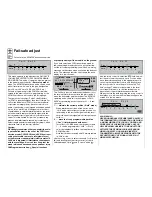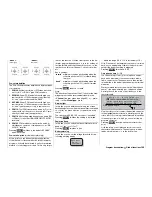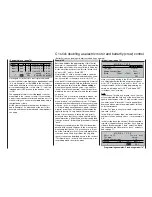
158
mx
-24s programming techniques
Preparation, e. g. for a fi xed-wing model aircraft
Programming examples: Fixed-wing model
Programming model data into an
mx
-24s …
... is easier than it may appear at fi rst sight.
There is one basic rule which applies equally to all
programmable radio control transmitters: if the pro-
gramming is to go smoothly and the systems work as
expected, the receiving system components must fi rst
be installed correctly in the model, i. e. the mecha-
nical systems must be fi rst-rate. This means: ensure
that each servo is at its correct neutral position when
you fi t the output lever or disc and connect the linka-
ge to it. If you fi nd this is not the case, correct it! Re-
move the output arm, rotate it by one or more splines
and secure it again. If you use a servo tester, e. g. the
Digital Servo Analyzer, Order No.
763
, to centre the
servos, you can be certain that their neutral position
is exactly correct.
Virtually all modern transmitters offer facilities for off-
setting the neutral position of servos, but this is no
substitute for a correct mechanical installation;
it is
only intended for fi ne tuning
. Any substantial deviati-
on from the “0” position may result in additional asym-
metry when the signal undergoes further processing
in the transmitter. Think of it this way: if the chassis of
a car is distorted, you may be able to persuade the
vehicle to run straight by holding the steering wheel
away from centre, but it does not make the chassis
any less bent, and the basic problem of ineffi ciency
remains.
Another important point is to set up the correct cont-
rol travels as far as possible by using the appropriate
linkage points in the mechanical system; this is much
more effi cient than making major changes to the tra-
vel settings at the transmitter. The same rule applies:
electronic travel adjustment facilities are designed pri-
marily to compensate for minor manufacturing tole-
rances in the servos and
for fi ne adjustment
, and not
to compensate for poor-quality construction and de-
fective installation.
If – as is usual nowadays – two separate aileron ser-
vos are installed in a fi xed-wing model aircraft, the ai-
lerons can also be employed as airbrakes by defl ec-
ting both of them up – simply by setting up a suitab-
le mixer which superimposes a fl ap function on them
(see the section starting on page 110). Such systems
are generally more often used in gliders and electric
gliders than in power models.
In such cases the servo output arms should be offset
forward by one spline relative to the neutral point, i. e.
towards the leading edge, and fi tted on the servo out-
put shaft in that position. The mechanical differential
achieved by this asymmetrical installation takes into
account the fact that the braking effect of the up-going
ailerons increases with their angle of defl ection, and
this means that much less travel is usually required in
the down-direction than the up-direction.
Similar reasoning applies to the installation of the fl ap
linkage when separate fl ap servos are installed, desi-
gned to be used in a butterfl y (crow) braking system.
Here again an asymmetrical linkage point is useful.
The braking effect of the crow system is provided pri-
marily by the down-movement of the fl aps rather than
the up-movement of the ailerons, so in this case the
servo output arms should point aft, i. e. offset towards
the trailing edge, as this makes greater travel availab-
le for the down-movement. When this combination of
lowered fl aps and raised ailerons is used, the ailerons
should only be raised to a moderate extent, as their
primary purpose in this confi guration is to stabilise
and control the model rather than act as brakes.
You can “see” the difference in terms of braking effect
by deploying the crow system, then looking at the un-
derside of the wing from the front. The larger the pro-
jected area of the defl ected control surfaces, the gre-
ater the braking effect.
This type of asymmetrical installation of the servo
output arms can also make sense when setting up
split fl aps or landing fl aps on a power model.
Once you have completed your model and set up the
mechanical systems accurately in this way, you are
ready to start programming the transmitter.
The instructions in this section are intended to re-
fl ect standard practice by describing the basic gene-
ral settings fi rst, and then refi ning and specialising
them to complete the set-up. After the fi rst test-fl ight,
and in the course of continued test-fl ying, you may
need to adjust one or other of the model’s settings. As
your piloting skills improve and you gain experience,
you might want to try out different control systems
and other refi nements, and to cater for these require-
ments you may fi nd that the text deviates from the ob-
vious order of options, or that one or other of the opti-
ons is mentioned more than once.
The contrary may also be true: for a particular mo-
del not every one of the steps described in this sec-
tion will be relevant, just as one or other of you may
miss a particular step in the description for his parti-
Содержание mx-24s
Страница 1: ...1...
Страница 19: ...19 For your notes...
Страница 35: ...35 For your notes...
Страница 41: ...41 41 For your notes...
Страница 57: ...57 For your notes...
Страница 63: ...63 63 For your notes...
Страница 69: ...69 69 For your notes...
Страница 85: ...85 85 For your notes...
Страница 99: ...99 For your notes...
Страница 143: ...143 For your notes...
Страница 191: ...191 For your notes...
Страница 212: ...212 212 For your notes...
Страница 213: ...213 213 For your notes...
Страница 214: ...214 For your notes...
Страница 216: ...216...
















































